ASM Metals HandBook Vol. 14 - Forming and Forging
Подождите немного. Документ загружается.

40. A.G. Schloeman-Siemag, private communication, Sept 1979
41. J. Spyra and J. Ludyga, Mechanization of Roll Engineering Calculations Using
Modern Electronic
Computers, Kalibreur, Vol 28, 1978, p 3
42. J. Metzdorf, Computer Aided Roll Pass Design--Possibilities of Application, Kalibreur,
(No. 34), 1981, p
29 (in German and French)
43. F. Schmeling, Computer Aided Roll Pass Design and Roll Manufacturing, Stahl Eisen,
Vol 102, 1982, p
771 (in German)
44. Construction and Operation of Rolling Mills, chapter 23 in The Making, Shaping, and Treating of Steel,
10th ed., W.T. Lankford, Jr. et al., Ed., U.S. Steel/Association of Iron and Steel Engineers, 1985
45. S.S. Hansen, Microalloyed Plate and Bar Products: Production Technology, in
Fundamentals of
Microalloying Forging Steels, G. Krauss and S. Banerji, Ed., The Metallurgical Society, 1987, p 155-
174;
also Microalloying '75, Union Carbide Corp., 1977
46. "Reynolds Flexible Packaging," Pamphlet 410-1-1, Reynolds Metals Company, 1984
47. J.H. Mendenhall, Ed., Understanding Copper Alloys, Olin Brass Corporation, 1977
48. A.A. Popoff, J.A. Walowit, S.K. Batra, and R.J. Fiorentino, Development of a
Process Utilizing Heated
Rolls for Hot Rolling Metals, Manufacturing Engineering Transactions, Vol 1, 1972, p 34-42
49.
T.G. Byrer, J.R. Douglas, D. Becker, J.D. Buzzanell, R.O. Kaufman, and H.L. Black, unpublished
research, Battelle Columbus Laboratories and Cyclops Corp., Sept 1975
50. S.K. Batra and A.A. Popoff, On the Use of Heated Rolls for Hot Rolling of Metals, J. Eng.
Mater.
Technol., Trans. ASME, Vol 95H, 1976, p 27-35
51. A.A. Popoff, T.G. Byrer, and R.J. Fiorentino, Studies on the Application of the Heated-
Roll Concept to
Hot Rolling Metals, Final Report on Contract N00019-69-
0288 to the Naval Air Systems Command,
Battelle Memorial Institute, June 1970
52. W.J. Carpenter, F.K. Rose, and A.G. Metcalfe, unpublished research, Solar Turbines Inte
rnational, Oct
1974

Introduction to Workability
George E. Dieter, University of Maryland
Introduction
WORKABILITY refers to the relative ease with which a metal can be shaped through plastic deformation. The term
workability is often used interchangeably with the term formability, which is preferred when referring to the shaping of
sheet metal parts (see the Section "Evaluation of Formability for Secondary (Sheet) Forming" in this Volume). However,
workability is usually used to refer to the shaping of materials by such bulk deformation processes as forging, extrusion,
and rolling.
The characterization of the mechanical behavior of a material by tension testing measures two different types of
mechanical properties: strength properties (such as yield strength and ultimate strength) and ductility properties (such as
percentage of elongation and reduction in area). Similarly, the evaluation of workability involves both measurement of
the resistance to deformation (strength) and determination of the extent of possible plastic deformation before fracture
(ductility). Therefore, a complete description of the workability of a material is specified by its flow stress dependence on
processing variables (for example, strain, strain rate, preheat temperature, and die temperature), its failure behavior, and
the metallurgical transformations that characterize the alloy system to which it belongs.
However, the major emphasis in workability is on measurement and prediction of the limits of deformation before
fracture.Therefore, the emphasis in this article is on methods for determining the extent of deformation a metal can
withstand before cracking or fracture occurs. It is important, however, to allow for a more general definition in which
workability is defined as the degree of deformation that can be achieved in a particular metalworking process without
creating an undesirable condition. Generally, the undesirable condition is cracking or fracture, but it may be another
condition, such as poor surface finish, buckling, or the formation of laps, which are defects created when metal folds over
itself during forging.In addition, in the most general definition of workability, the creation by deformation of a
metallurgical structure that results in unsatisfactory mechanical properties, such as poor fracture toughness or fatigue
resistance, can be considered to be a limit on workability.
In the restricted context of the forging process, the relative ability of a material to deform without fracture is termed
forgeability.Because the ability of the material to flow readily and to fill the die recesses completely is important, this is
another aspect of forgeability. This aspect of forgeability is measured by the flow stress of the material. Methods of
measuring flow stress are briefly discussed in this article and are treated in more detail in the Section "Computer-Aided
Process Design for Bulk Forming".
Generally, workability depends on the local conditions of stress, strain, strain rate, and temperature in combination with
material factors, such as the resistance of a metal to ductile fracture. In addition to a review of the many process variables
that influence the degree of workability, the mathematical relationships that describe the occurrence of room-temperature
ductile fracture under workability conditions are summarized in this article. The most common testing techniques for
workability prediction are discussed in the article "Workability Tests" in this Section.
Introduction to Workability
George E. Dieter, University of Maryland
Material Factors Affecting Workability
Fracture Mechanisms. Fracture in bulk deformation processing usually occurs as ductile fracture, rarely as brittle
fracture.However, depending on temperature and strain rate, the details of the ductile fracture mechanism will vary.
Figure 1 illustrates the different modes of ductile fracture obtained in a tension test over a wide range of strain rates and
temperatures. At temperatures below about one-half the melting point of a given material (below the hot-working region),
a typical dimpled rupture type of ductile fracture usually occurs. A more commonly found representation of possible
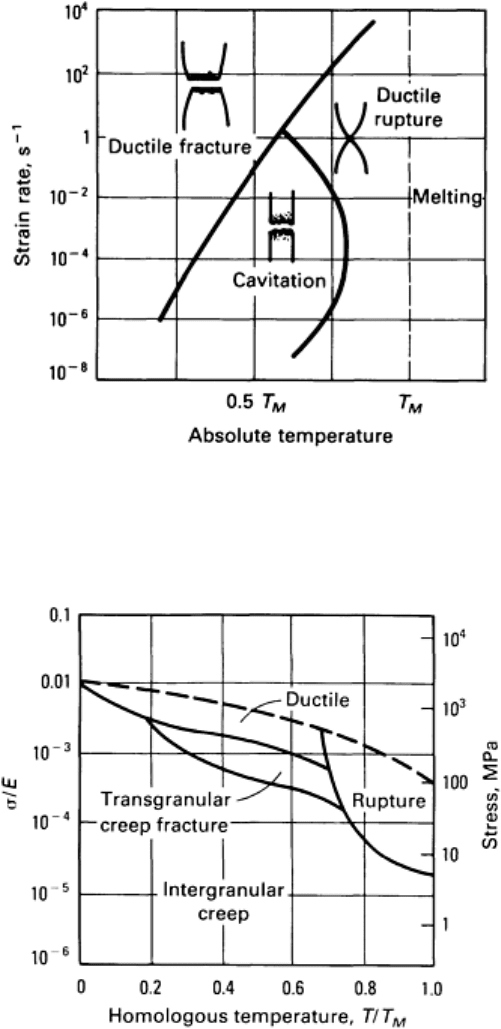
fracture mechanisms is the fracture mechanism (Ashby) map (Fig. 2). Such a map shows the area of dominance of each
fracture mechanism. The maps are constructed chiefly by using the best mechanistic models of each fracture process.
Fig. 1
Tensile fracture modes as a function of temperature (measured on the absolute temperature scale) and
strain rate.
Fig. 2 Fracture mechanism map for nickel.
The three stages of ductile fracture are shown schematically in Fig. 3. The first stage is void initiation, which usually
occurs at second-phase particles or inclusions.Voids are initiated because particles do not deform, and this forces the
ductile matrix around the particle to deform more than normal. This in turn produces more strain hardening, thus creating
a higher stress in the matrix near the particles. When the stress becomes sufficiently large, the interface may separate, or
the particle may crack. As a result, ductility is strongly dependent on the size and density of the second-phase particles, as
shown in Fig. 4.
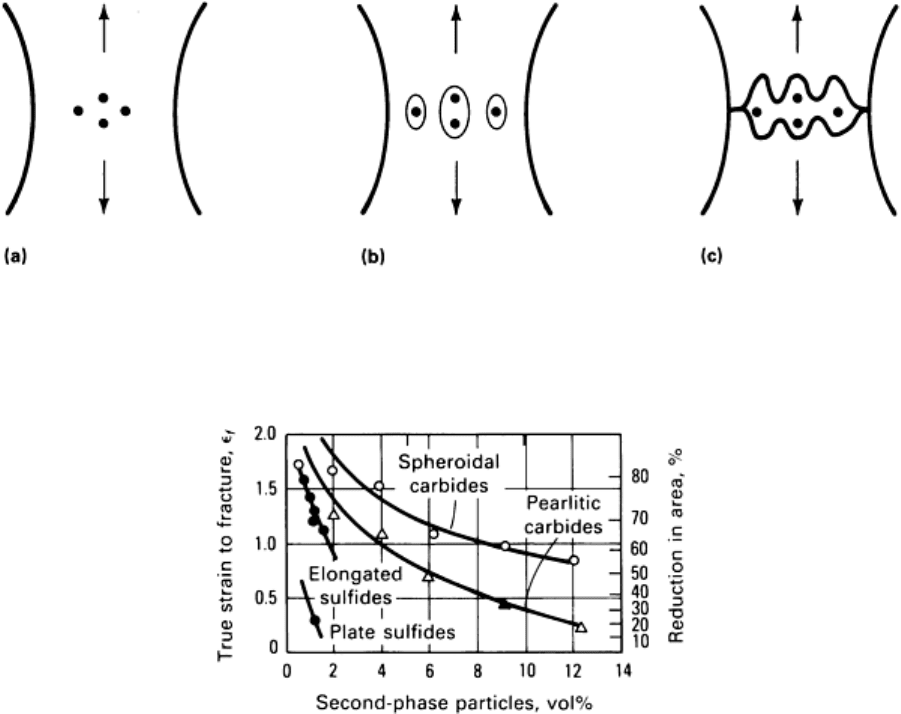
Fig. 3 Stages in the dimple rupture mode of ductile fracture. (a) Void initiation. (b) Void growth.
(c) Void
linking.
Fig. 4 Effect of volume fraction of second-phase particles on the tensile ductility of steel. Source: Ref 1.
The second stage of ductile fracture is void growth, which is a strain-controlled process. Voids elongate as they grow, and
the ligaments of matrix material between the voids become thin. Therefore, the final stage of ductile fracture is hole
coalescence through the separation of the ligaments, which links the growing voids.
Ductile fracture by void growth and coalescence can occur by two modes. Fibrous tearing (Mode I) occurs by void
growth in the crack plane that is essentially normal to the tensile axis. In Mode II void growth, voids grow in sheets at an
oblique angle to the crack plane under the influence of shear strains. This type of shear band tearing is found on the
surface of the cone in a ductile cup-and-cone tensile fracture. It commonly occurs in deformation processing, in which
friction and/or geometric conditions produce inhomogeneous deformation, leading to local shear bands. Localization of
deformation in these shear bands leads to adiabatic temperature increases that produce local softening.
Increasing the temperature of deformation leads to significant changes in deformation behavior and fracture mode. At
temperatures above one-half the melting point, particularly at low strain rates, grain-boundary sliding becomes prominent.
This leads to wedge-shaped cracks that propagate along grain boundaries and result in low ductility (Fig. 5).
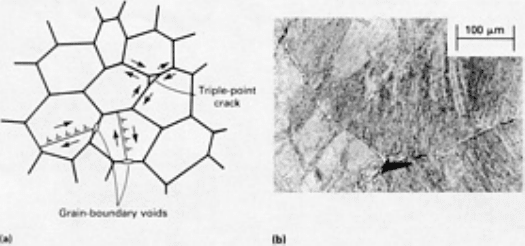
Fig. 5 Formation of grain-boundary voids (cavitation) and triple-point cracks at warm- and hot-
working
temperatures. (a) Schematic showing how grain-
boundary voids are formed under the action of matrix
deformation and how grain-boundary sliding in the absence of grain-
boundary migration and recrystallization
may cause cracks to open at triple points. (b) Examples of grain-boundary voids and triple-
point cracking at the
prior β grain boundaries in hot-forged Ti-6Al-2Sn-4Zr-2Mo-0.1Si with a Widmanstätten α start
ing
microstructure. Source: Ref 2, 3.
The probability of wedge cracking varies with the applied strain rate. If the strain rate is so high that the matrix deforms at
a faster rate than the boundaries can slide, then grain-boundary sliding effects will be negligible, and wedge cracking will
not occur. If the strain rate is very low, sufficient time is available to relax the high stresses at the triple points, and a
different fracture mechanism comes into play.
Round or elliptical cavities form in grain boundaries at high temperatures, but form at lower stresses than those that
produce wedge-shaped cracks. Nevertheless, like wedge cracks, these cavities are formed by grain-boundary shearing.
With low strain rates (<1 s
-1
), the initiation of voids by grain-boundary sliding and the reduced rate of dynamic
recrystallization can result in extensive internal void formation, or cavitation. Cavitation is germane with respect to
ductility in creep, but it is generally not a factor in fracture in hot working.
For high-temperature fracture initiated by grain-boundary sliding, the processes of void growth and coalescence, rather
than void initiation, are the primary factors that control ductility. When voids initiated at the original grain boundaries
have difficulty in linking because boundary migration is high as a result of dynamic recrystallization, hot ductility is high.
In extreme cases, this can lead to highly ductile rupture, as shown in Fig. 1.
Compressive stresses superimposed on tensile or shear stresses by the deformation process can have a significant
influence on closing small cavities or limiting their growth and thus enhancing workability. Because of this important role
of the stress state, it is not possible to express workability in absolute terms. Workability depends not only on material
characteristics but also on process variables, such as strain, strain rate, temperature, and stress state.
A processing map can be developed considering all of the failure mechanisms that can operate in a material over a range
of strain rates and temperatures. The processing map is a useful concept that should gain wider acceptance in the study of
material response in deformation processing.
Figure 6 illustrates a processing map for aluminum that is based on theoretical models; however, it agrees well with
experimental work. A safe region is indicated in which the material should be free from cavitation damage or flow
localization. The processing map predicts that, at constant temperature, there should be a maximum in ductility with
respect to strain rate. For example, at 500 K (227 °C, or 440 °F), ductility should be at a maximum at a strain rate of 10
-3
to 1 s
-1
. Below the lower value, wedge cracking will occur; above this level, ductile fracture would reduce ductility.
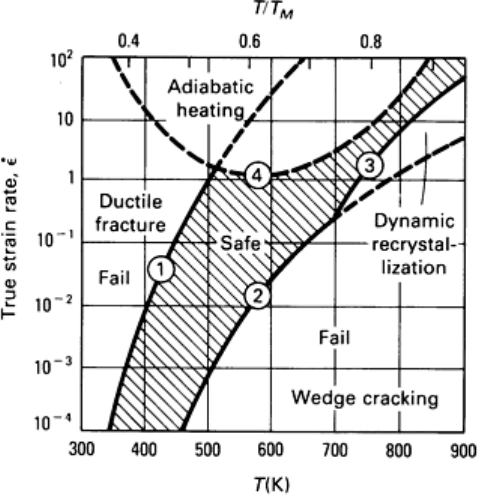
Fig. 6 Composite processing map for aluminum showing the safe region for forming. Boundarie
s shift with
microstructure. Instabilities due to purely continuum effects, such as shear localization in sheet metal forming,
are not considered. Source: Ref 4.
The safe region shown in Fig. 6 is sensitive to the microstructure of the metal. Decreasing the size and volume fraction of
hard particles would move boundary 1 to the left. Increasing the size or fraction of hard particles in the grain boundary
would make sliding more difficult and would move boundary 2 to the right. More detailed information on fracture
mechanisms can be found in the article "Modes of Fracture" in Fractography, Volume 12 of ASM Handbook, formerly
9th Edition Metals Handbook.
Flow Localization. Workability problems can arise when metal deformation is localized to a narrow zone. This results
in a region of different structures and properties that can be the site of failure in service. Localization of deformation can
also be so severe that it leads to failure in the deformation process. In either mode, the presence of flow localization needs
to be recognized.
Flow localization is commonly caused by the formation of a dead-metal zone between the workpiece and the tooling. This
can arise from poor lubrication at the workpiece/tool interface. Figure 7 illustrates the upsetting of a cylinder with poorly
lubricated platens. When the workpiece is constrained from sliding at the interface, it barrels, and the friction-hill pressure
distribution is created over the interface. The inhomogeneity of deformation throughout the cross section leads to a dead
zone at the tool interface and a region of intense shear deformation.
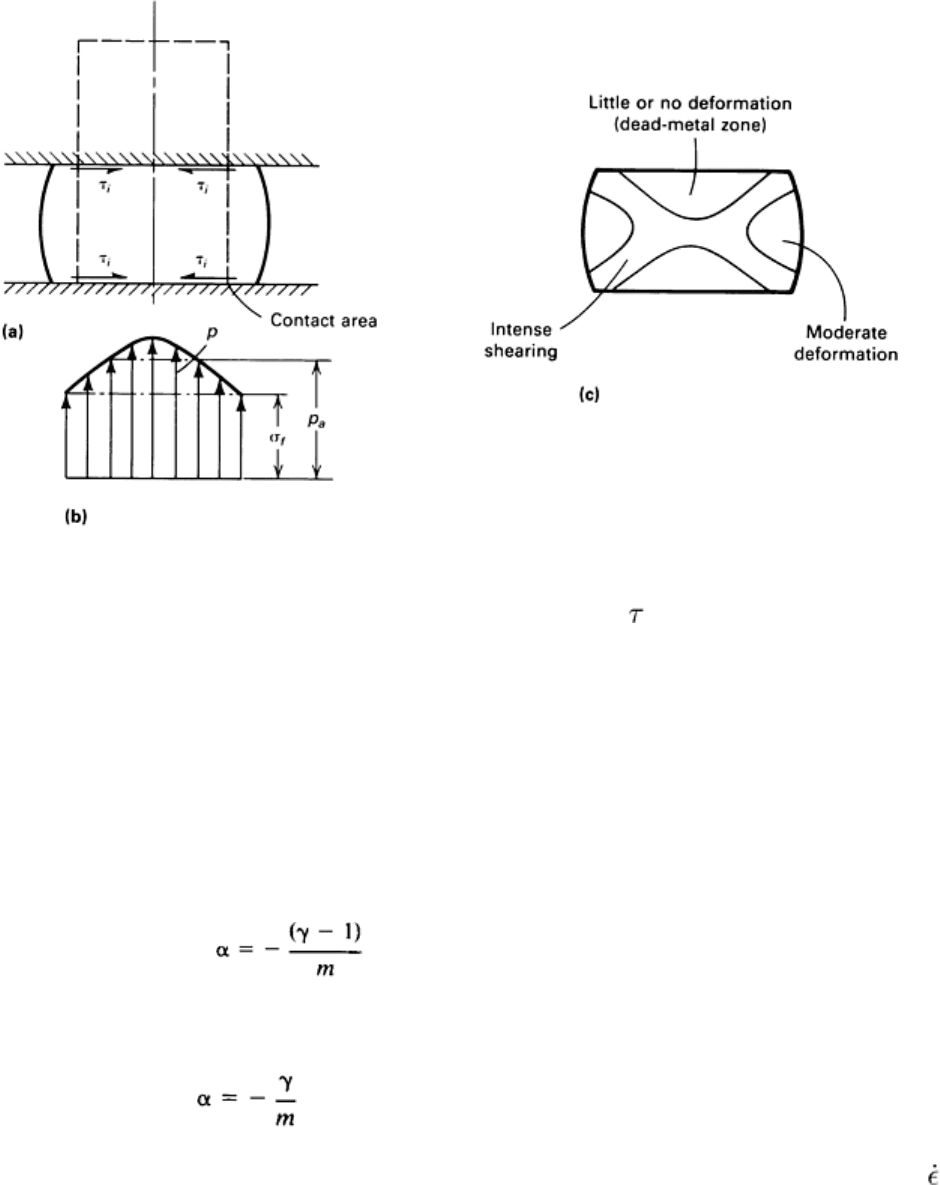
Fig. 7
Consequences of friction illustrated in the upsetting of a cylinder. (a) Direction of shear stresses. (b)
Consequent rise in interface pressure. (c) Inhomogeneity of deformation.
i
, average frictional shear stress; p,
normal pressure; σ
f
, flow stress; p
a
, average die pressure.
A similar situation can arise when the processing tools are cooler than the workpiece; in this case, heat is extracted at the
tools. Consequently, the flow stress of the metal near the interface is higher because of the lower temperature.
However, flow localization may occur during hot working in the absence of frictional or chilling effects. In this case,
localization results from flow softening (negative strain hardening). Flow softening arises during hot working as a result
of structural instabilities, such as adiabatic heating, generation of a softer texture during deformation, grain coarsening, or
spheroidization. Flow softening has been correlated with materials properties (Ref 5) by the parameter:
(Eq 1)
for upset compression and
(Eq 2)
for plane-strain compression where γ= (1/σ)dσ/dε is the normalized flow-softening rate, and m = d log σ/d log is the
strain rate sensitivity. In α+ β titanium alloys and other materials that exhibit a strong tendency toward flow localization,
this phenomenon is likely to occur when the parameter α is greater than 5. Figure 8 shows a crack that initiated in a shear
band during the high-energy-rate forging of a complex austenitic stainless steel.

Fig. 8 Austenitic stainless steel high-energy-rate-
forged extrusion. Forging temperature: 815 °C (1500 °F);
65% reduction in area; = 1.4 × 10
3
s
-1
. (a) View of extrusion showing spiral cracks. (b) Optical micrograph
showing the microstructure at the tip of one of the cracks in the extrusion (area A). Note that the c
rack initiated
in a macroscopic shear band that formed first at the lead end of the extrusion. Etchant: Oxalic acid. Source:
Ref
6.
Metallurgical Considerations. The common failure modes occurring in deformation processing are summarized in
Table 1. Three temperature regions are common: cold working, warm working, and hot working. Two types of ductile
fracture are distinguished in cold working, depending on the stress state. Free surface fracture occurs at a free surface
when there is no stress normal to the surface, while centerburst-type failure occurs at the center of the bar or forging
because of high hydrostatic tension.
Table 1 Common failure modes in deformation processing
Metallurgical defects in: Temperature
regime
Cast grain structure Wrought (recrystallized) grain structure
Cold working
(a)
Free surface fracture, dead metal zones (shear bands,
shear cracks), centerbursts, galling
Warm working
(b)
Triple-point cracks/fractures, grain-boundary
cavitation/fracture
Hot working Hot shortness, centerbursts, triple-point cracks/fractures, Shear bands/fractures, triple-point cracks/fractures,
(a)
Cold working of cast structures is typically performed only for very ductile metals (such as dental alloys) and usually involves many stages of
working with intermediate recrystallization anneals.
(b)
Warm working of cast structures is rare.
Workability problems depend greatly on grain size and grain structure. When the grain size is large relative to the overall
size of the workpiece, as in conventionally cast ingot structures, workability is lower, because cracks may initiate and
propagate easily along the grain boundaries. Moreover, with cast structures, impurities are frequently segregated to the
center and top or to the surface of the ingot, creating regions of low workability. Because chemical elements are not
distributed uniformly on either a micro- or a macroscopic scale, the temperature range over which an ingot structure can
be worked is rather limited.
Typically, cast structures must be hot worked. The melting point of an alloy in the as-cast condition is usually lower than
that of the same alloy in the fine-grain, recrystallized condition because of chemical inhomogeneities and the presence of
low melting point compounds that frequently occur at grain boundaries. Deformation at temperatures too close to the
melting point of these compounds may lead to grain-boundary cracking when the heat developed by deformation
increases the workpiece temperature and produces local melting.
This fracture mode is called hot shortness. This type of fracture can be prevented by using a sufficiently low deformation
rate that allows the heat developed by deformation to be dissipated by the tooling, by using lower working temperatures,
or by subjecting the workpiece to a homogenization heat treatment prior to hot working. The relationship between the
workability of cast and wrought structures and temperatures is shown in Fig. 9.
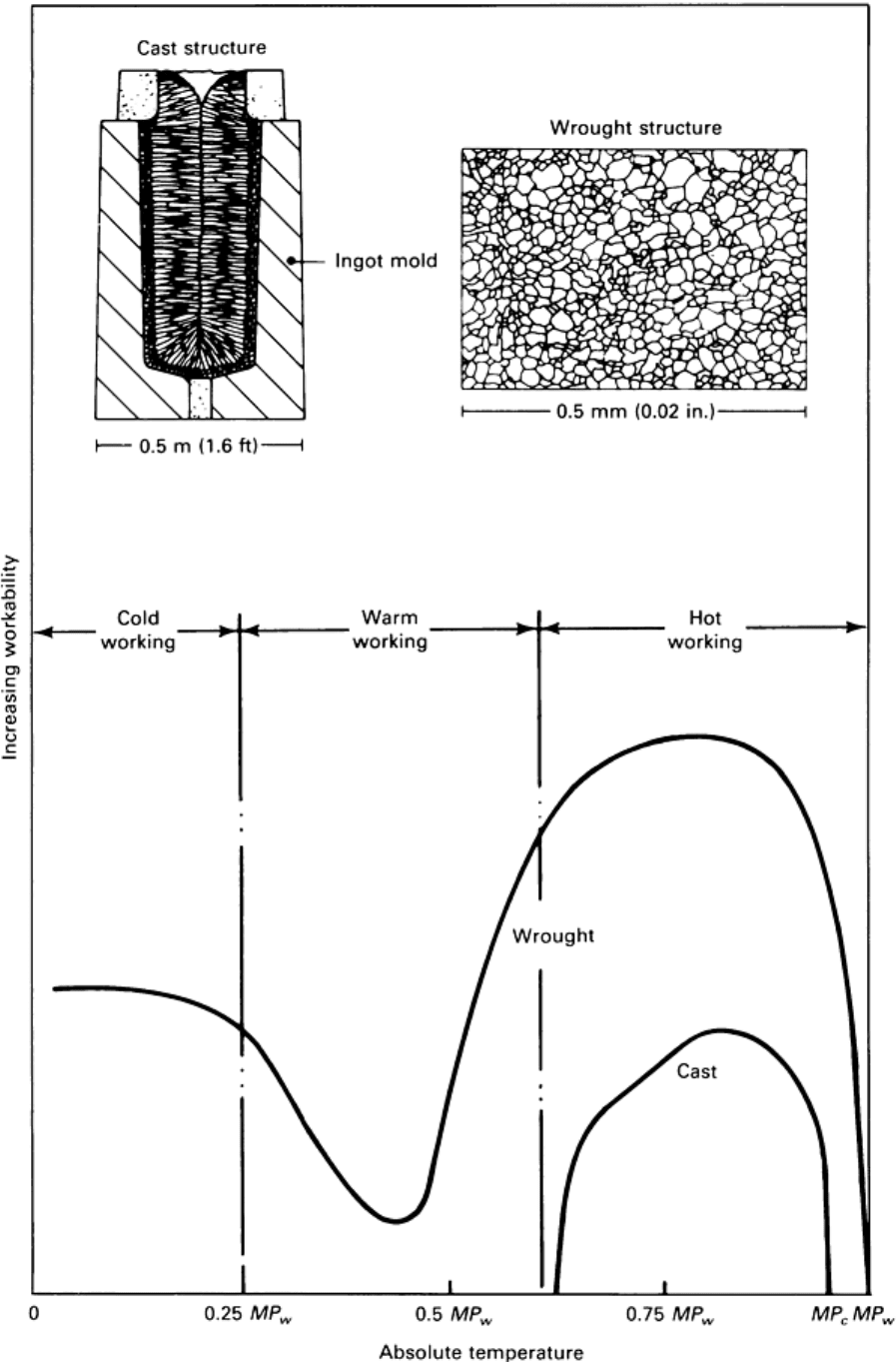
Fig. 9 Relative workabilities of cast metals and wrought recrystallized metals at cold-, warm-, and hot-
working
temperatures. The melting point (or solidus temperature) is denoted as MP
c
(cast metals) or MP
w
(wrought and
